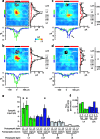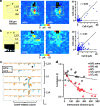Laminar and columnar organization of ascending excitatory projections to layer 2/3 pyramidal neurons in rat barrel cortex
- PMID: 15958733
- PMCID: PMC6724876
- DOI: 10.1523/JNEUROSCI.1173-05.2005
Laminar and columnar organization of ascending excitatory projections to layer 2/3 pyramidal neurons in rat barrel cortex
Abstract
Excitatory synaptic projections to layer 2/3 (L2/3) pyramidal neurons in brain slices from the rat barrel cortex were measured using quantitative laser-scanning photostimulation (LSPS) mapping. In the barrel cortex, cytoarchitectonic "barrels" and "septa" in L4 define a stereotypical array of landmarks, allowing alignment and averaging of LSPS maps from multiple cells in different slices. We distinguished inputs to L2 and L3 neurons above barrels and septa. Average input maps revealed that barrel-related ascending projections (L4-->2/3barrel) interdigitated with a novel septum-related projection (L5A-->2septum). We also explored the functional organization of these projections by comparing the input maps of multiple cells in individual slices. L2/3 cells sharing the same barrel-related column showed strong correlations in their input maps, independent of their precise locations within the column; otherwise, correlations fell rapidly as a function of intersomatic separation. Our data indicate that barrel-related and septum-related columns are associated with distinct functional circuits. These projections are likely to mediate parallel processing of somatosensory signals within the barrel cortex, with L4-->2/3barrel and L5A-->2septum representing the intracortical continuations of, respectively, the subcortical lemniscal and paralemniscal systems conveying somatosensory information to the barrel cortex.
Figures





References
-
- Agmon A, Connors BW (1991) Thalamocortical responses of mouse somatosensory (barrel) cortex in vitro. Neuroscience 41: 365-379. - PubMed
-
- Ahissar E, Sosnik R, Haidarliu S (2000) Transformation from temporal to rate coding in a somatosensory thalamocortical pathway. Nature 406: 302-306. - PubMed
-
- Allen CB, Celikel T, Feldman DE (2003) Long-term depression induced by sensory deprivation during cortical map plasticity in vivo. Nat Neurosci 6: 291-299. - PubMed
-
- Armstrong-James M (1995) The nature and plasticity of sensory processing within adut rat barrel cortex. In: The barrel cortex of rodents, Ed 1 (Jones EG, Diamond IT, eds), p 446. New York: Plenum.
-
- Armstrong-James M, Fox K (1987) Spatiotemporal convergence and divergence in the rat S1 “barrel” cortex. J Comp Neurol 263: 265-281. - PubMed
Publication types
MeSH terms
Substances
LinkOut - more resources
Full Text Sources
Other Literature Sources
Miscellaneous
